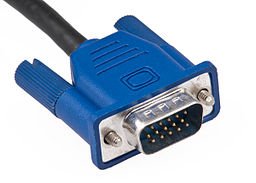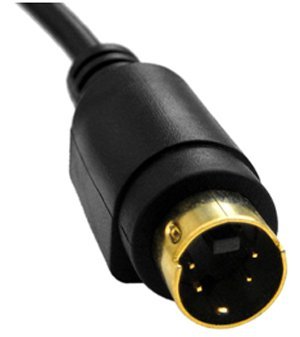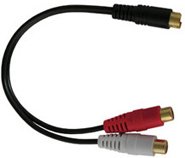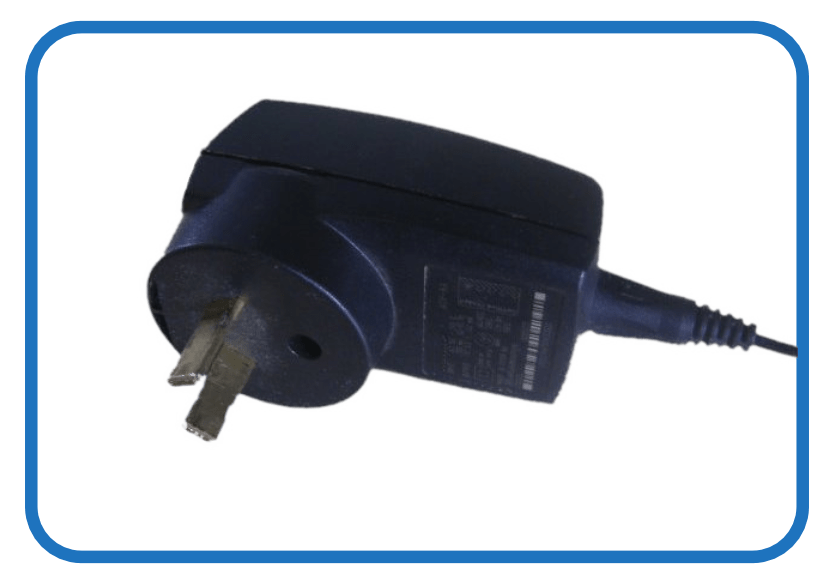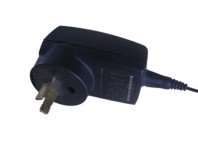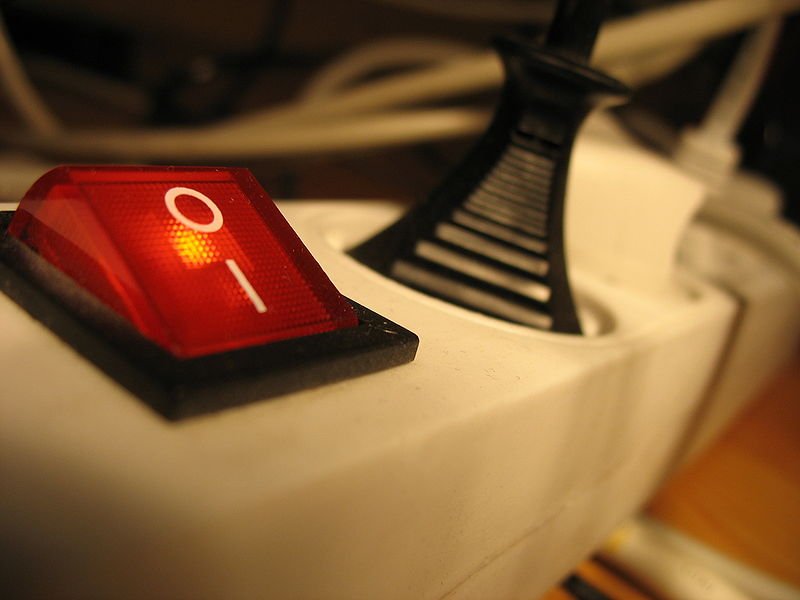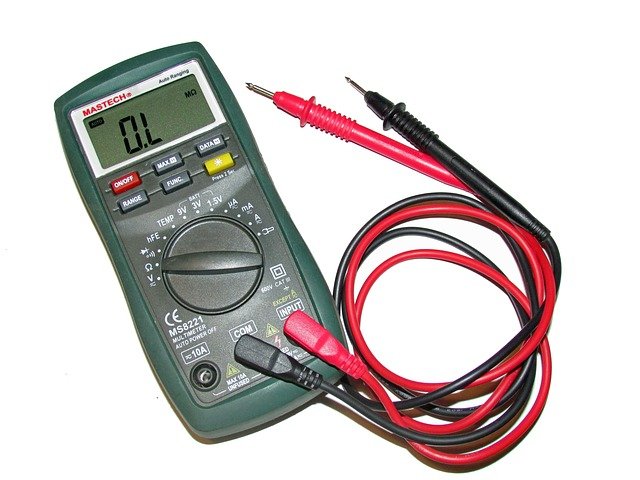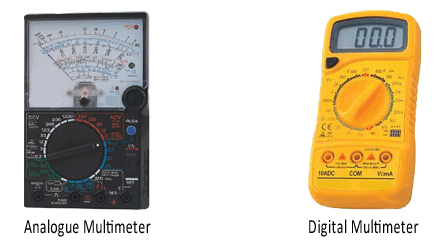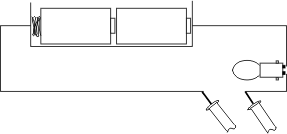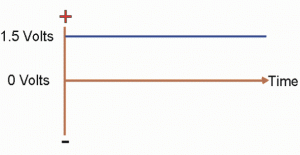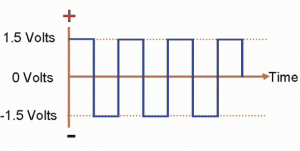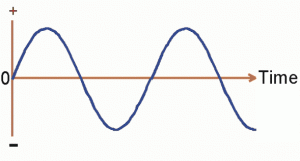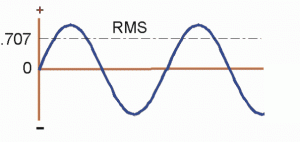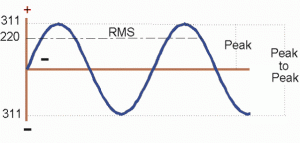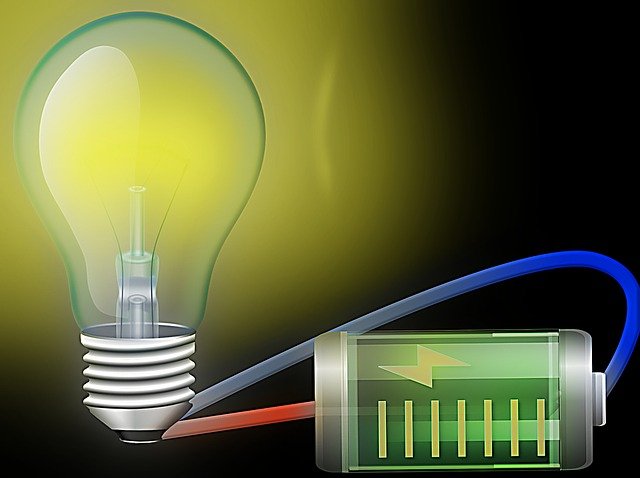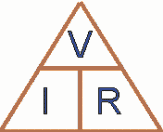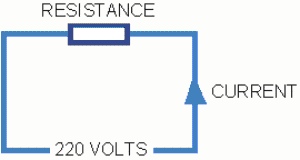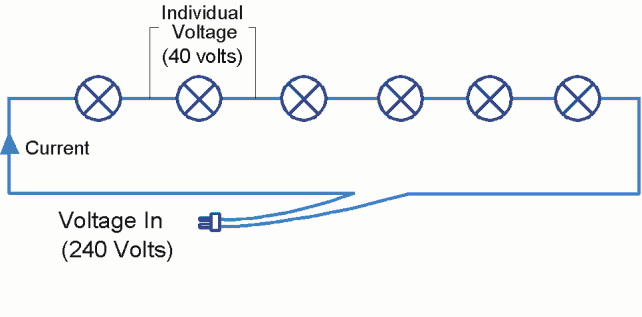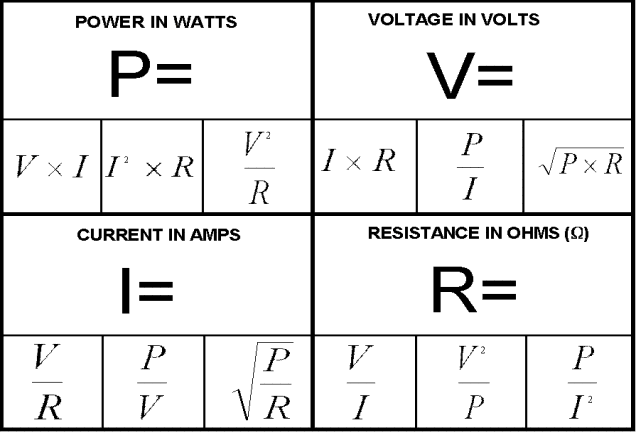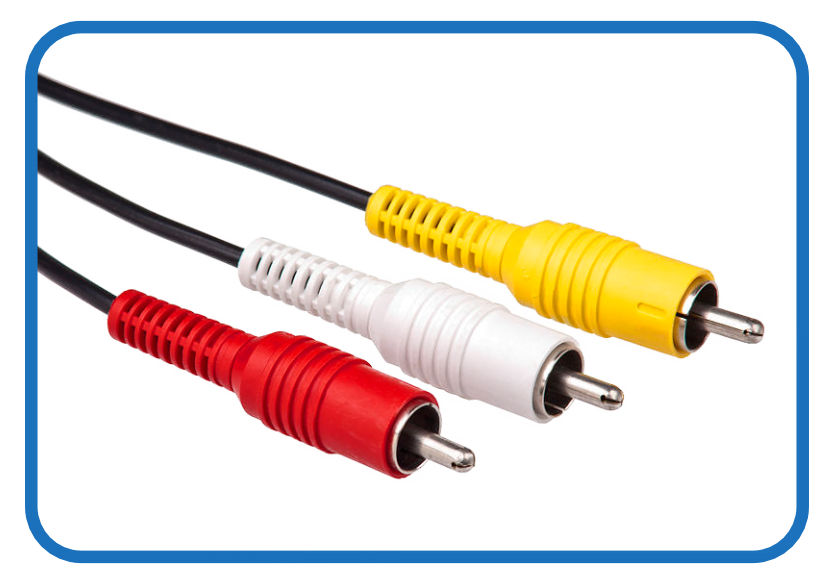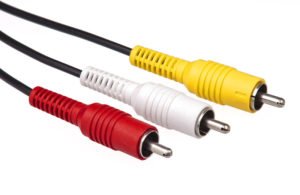This article introduces the basic concepts of multimeters and explains how to use them for basic measurements. Multimeters are one of the most useful electrical and electronic aids available to us. Effectively they are our eyes to see electricity. The ability to use a multimeter is essential if you need to know what is going on electrically. A multimeter is, as the name suggests, a meter capable of multiple functions. A basic meter will allow us to measure and test AC voltages, DC voltages, DC polarity, resistance and often current. More advanced meters also measure frequency, capacitance, transistor gain, and/or inductance.
Analog vs Digital Multimeter
Multimeters come in many shapes and sizes. However there are basically two types:
The basic differences are outlines in the following table:
| Analogue meters | Digital meters |
|---|
| 1. Indicate with a pointer that moves across the face of the meter. | 1. Display the measured value in actual digits (numbers). |
| 2. Not as accurate as a precisely calibrated digital meter. | 2. Normally regarded as more accurate than analogue (only if they have been correctly calibrated). |
| 3. Can require some practice to quickly read exact voltages, although they are very useful in showing that a voltage is present. | 3. Easier to read exact values than on analog meters. However this is often an over kill when all you need to know is if a voltage exists or not. |
| 4. Especially suited to measuring voltages that vary quickly. The pointer closely follows the voltage as it varies up or down quickly. | 4. Display misleading results if the measured voltage varies quickly. This is because most digital meters require a second or more to read the measured voltage. If the voltage varies greatly during this time, then the reading will be wrong. |
| 5. Only require a battery when measuring resistance. | 5. Require a good battery to work on all settings. |
If you don’t own a meter, or cannot readily borrow one, then it is time to invest in one. A basic meter will probably be adequate for your needs. That is one that simply reads AC and DC volts, resistance and DC current. The choice between analogue and digital is yours, and will depend on availability as much as your budget and preferences. It is not recommended to pay too much money for your first multimeter, as your use of it may not be justified. However a meter that does the basics is very usful.
Click here to browse
simple power meters available from
AmazonDisclosure: If you buy through this link Geoff receives a small commission from Amazon
Digital meters are commonly available in most electronic stores. Analogue meters are often regarded as “old technology”. However in many situations an analogue meter may be the only meter available that is working (since they don’t require batteries to read voltages). Both types of meters will be discussed in this chapter. If you have a meter, please have it with you as you read this article. Read the instructions for your particular meter to be aware of its functions. Where possible use your meter to do the exercises as practical examples.
Measuring Voltages on your Multimeter
No matter what sort of meter you have, you need to know roughly what sort of voltage you are measuring. The first choice is between AC and DC. As a guideline, common sources are:
For AC: transformers, alternators (often erroneously called generators), house wiring, light sockets, power outlets (wall sockets).
For DC: batteries, solar panels, cars, electronic equipment.
Once you have determined if you will be measuring AC or DC, you need to select this on your multimeter. Refer to your meter instructions. Most meters will not be damaged by selecting AC instead of DC, or DC instead of AC. However the meter won’t read correctly, if at all.
The next step is to consider roughly the magnitude of the voltage you will be testing. Then select on your meter a range that is bigger than that voltage.
Example 1: You want to measure the voltage at the wall outlet. It should be 220 or 240 volts, select the 250 or 300 volts range on AC.
Example 2: You want to measure the voltage of your car battery. It should be 12 volts. Select the 15, 20, 25, 30 or 50 volt range on DC, (depending on your meter’s ranges).
If you are not sure what the voltage should be, then start on the highest range.
Analogue Meter
| Digital Meter
|
|---|
| If the meter pointer only moves a tiny bit, then select a smaller range. Continue to select a smaller range until the pointer is midway or higher. | If the readout reads 0.01 or a similar very low reading, select a lower range until a more meaningful reading is displayed. |
| If the pointer goes off the scale (all the way over the right-hand side) then you need to quickly remove the probes, select a higher range, then measure again | If the range selected is too high, most meters will display OL or -1 or similar indicating overload or out of range. |
Some (more expensive) digital meters have a feature called “auto-select” or “auto-ranging”. This means that the meter will automatically select the appropriate range for the voltage you are measuring. With these meters, all you need do is select AC or DC.
WHICH PROBE WHERE?
Every meter has two probes. One black probe and one red probe. The black one is generally connected to the negative(-) or common terminal of the meter. The red probe is generally connected to the positive(+) terminal of the meter.
[warning]
To avoid electric shock when measuring voltage or current, always hold only the plastic insulation on the probes.
DO NOT touch the metal pins
Measuring AC
When measuring AC, it doesn’t matter which probe goes to the phase (sometimes known as “active” or “hot”), and which probe goes to the neutral (sometimes known as the “cold”. That is, AC has no polarity (see the article on AC and DC for more details).
Exercise 1: To measure the voltage at a wall outlet, insert one probe in one hole and the other probe in the other hole. It doesn’t matter which probe goes where. Try it with your meter:
- Select AC volts, 250 or 300 volts range (depending on your meter’s ranges).
- Being sure not to touch the metal points of the probes, put one probe in one of the holes in the wall outlet. Put the other probe in the other outlet hole. Your meter should read somewhere near what the voltage should be (110, 220 or 240 volts).
- Now, still being sure not to touch the metal points of the probes, swap the probes over. That is, remove both probes from the outlet holes, swap them over and carefully re-insert them. Your meter should read the same as it did before. This shows it doesn’t matter which way the probes go when measuring AC.
Measuring DC
When measuring DC, you need to put the red probe to the positive(+), and the black wire to the negative(-) of the voltage being measured. If you mix this up and reverse the wires, then the meter will read backwards. That is, on analogue meters, the pointer will quickly move off the left-hand side of the scale. If this happens, no permanent damage normally occurs, simply reverse the way you have the probes. On digital meters, all that happens is that a “-” sign appears in front of the numbers indicating a negative voltage.
Exercise 2: To measure the voltage of a car battery.
- Select 15, 20 or 50 volts DC on your meter.
- Place the red positive probe on the battery positive terminal.
- Place the black negative probe on the battery negative terminal.
- A good battery should read between twelve and fourteen (12-14) volts.
A common use for a multimeter is to detect which lead from a battery or power supply is positive and which is negative. When you don’t know which is which, hold one probe on one of the leads to be tested, and then momentarily touch the other lead with the other probe. If, on an analogue meter, the pointer moves off to the left, then swap the probes over. When the meter reads correctly, the red probe is connected to the positive wire (or positive battery terminal). On a digital meter, if the “-” sign appears, then reverse the probes for the red lead to be connected to the positive.
Exercise 3: Detect the positive end of a small flashlight battery.
| Analogue Meter | Digital Meter |
|---|
| Ensure the red probe is connected to the positive terminal of the meter. | Ensure the red probe is connected to the positive terminal of the meter. |
| Select DC volts, and the 3 or 10 volts range (or whatever your meter has). | Select DC Volts, and the 2 volts range (or whatever your meter has). |
| Connect the black lead to either end of the battery. Momentarily touch the red probe against the other end of the battery. | Connect the black lead to either end of the battery. Touch the red probe against the other end of the battery |
| If the meter reads correctly, go on to the next step. If the pointer moves off to the left, change the probes around. That is, connect the black probe to the end you just momentarily touched with the red probe. Now touch the first end with the red probe. The meter should now read correctly. | If the meter reads correctly (i.e. no “-” sign), go on to the next step, if a “-” sign appears, change the probes around. That is, connect the black probe to the end you just touched with the red probe. Now touch the first end with the red probe. The meter should now read correctly |
| The end connected to the black probe is the negative(-) wire. The other end is positive(+). | The end connected to the black probe is the negative(-) wire. The other end is positive(+). |
Practical points to Note
1) The meter reads the voltage between the two probes, not necessarily the total voltage in the circuit. This may seem like a logical statement, but many people have been trapped by not understanding the difference.
2) Looking at the output voltage of a HiFi amplifier is best done with an analog meter.
Exercise 4: It doesn’t matter if you use the left or right channel, but you need to use the positive and negative terminal of the one channel.
- Select AC and the 50 volt range on your meter.
- Connect one probe to the negative speaker terminal.
- Connect the other probe to the positive speaker terminal.
- The meter pointer should dance up and down in time with the music. How far the needle moves will depend on the volume control.
This is not a very practical way of measuring the output, but it does give an interesting display. To properly measure the output capabilities of your HiFi amplifier you need other test equipment.
Measuring Resistance on your Multimeter
A useful feature of multimeters is their ability to measure the resistance in a circuit. Although the exact resistance in a circuit may not be useful to you, often knowing the relative resistance is. Example: Knowing the exact resistance of your clothes iron isn’t important. However knowing that there is some resistance (that of the heating element) tells you that it should work. No resistance indicates a broken connection which needs to be fixed.
The best way known to destroy your meter is to try to measure high voltage (like 220 volts AC) while still on the resistance range.
Always ensure the power is turned off and disconnected before measuring resistance
The method of setting your multimeter for measuring resistance is different for analogue and digital meters. Therefore, we will look at each separately.
| Analogue Multimeter | Digital Multimeter |
|---|
| 1. Select resistance. This is often signified by the Ohms symbol “Ω”. | 1. Select Resistance. This is often signified by the kilo-Ohms symbol kΩ. |
| 2. Calibrate the meter. To do this locate the “Ohm’s Adjust” knob, a small control like a volume control. Hold the metal points of the black and red probes together so that they touch each other. While they are still touching, move the “Ohm’s Adjust” control until the needle aligns with the far right-hand side of the scale. This should be “0” on the ohms scale (normally the top scale). | 2. Digital meters are pre-calibrated so no further calibration is required |
| 3. Place the probes across the resistance to be measured. For most resistance measurements it doesn’t matter which probe goes where – that is, it is not polarity conscious | 3. Place the probes across the resistance to be measured. For most resistance measurements it doesn’t matter which probe goes where – that is, it is not polarity conscious |
| 4. Read the number of ohms from the meter. The top scale usually is the scale to read for resistance. Assume the needle is pointing at “15”. If the range was Ω x 1, then you are measuring 15Ω. If the range is Ω x 10 then you are measuring 150Ω. Likewise Ω x 100 = 1500Ω and Ω x 1K = 15,000Ω or 15kΩ. If the needle is close to the left-hand side of the scale, select the next range.Example: the range is on Ω x 1. The needle is pointing at 1200. Change the range to Ω x 10 for the needle to point at 120. | 4. Read the number of ohms from the meter. The numbers displayed indicate the resistance in Ohms. Digital meters usually measure in Kilo-ohms (KΩ). Therefore if the meter is showing 1.5, it means 1.5KΩ, or 1,500Ω, not 1.5Ω. Take note of the little symbols indicating the range (if displayed). This is especially important on “auto-ranging” meters. Without noting that it is Ω, KΩ or MΩ you can easily be mis-led into a false reading |
| 5. If the resistance in the circuit being tested is very high, or no circuit at at all, then the needle won’t move. That is, the needle stays on the left-hand side of the scale, showing infinitive(∞) ohms | 5. If the resistance in the circuit being tested is very high, or no circuit at all, then the meter will try and tell you. There are various ways to indicate this condition. Some display OL, meaning “Open Loop” or “Over Load”. This means the resistance is so high it is considered to be no circuit at all, or at least outside the range of measurement. Some meters flash 1.999 to indicate this condition.Check to see what your meter does with both leads unconnected. |
Some common terms
Short Circuit: When there is zero resistance in the circuit, it is said to be a “short” circuit. This is shown on all meters by reading “0” (zero ohms) – or close to zero ohms.
Open Circuit: When there is so much resistance that the meter can’t register it, it is said to be “open” circuit. This usually indicates that there is no connection between the probes.
Note: When there is an open circuit, the meter can sometimes suggest some resistance (often measured in Mega-ohms). This is normally caused by touching the probes with your hands, and the meter is actually measuring your skin resistance.
Practical Uses of Measuring Resistance
As mentioned earlier, knowing the exact resistance in a circuit is often not as important as knowing if there is a circuit at all, if there is a short circuit, or if there is an open circuit. Try the following exercises as examples.
Exercise 5: Test a lead to see if it is faulty or not. This could be a lead from your HiFi, a power extension lead or a microphone lead.
- Select Resistance and the Ω x 1 scale. If using an analog meter, calibrate it to read 0Ω when shorting the probes together.
- Check the lead for short circuits. Using only one end of the lead, place a probe on each connection. Your meter should read infinitive resistance, saying there is no circuit between the two probes. If your meter shows close 0Ω, (a short circuit), then it needs to be fixed or replaced. The most common places for “shorts” to appear are in the plugs at either end.
- Check the lead for continuity. Using both ends of the lead, place one probe on the same point at each end. Your meter should show a short circuit (0Ω). Now do the same for the other connection on each end. If on either connection you do not get a short circuit, then there is not a continuous circuit in the lead where there should be. It probably means the lead is broken. The normal way to fix this is to cut 10cms off either end of the lead, check that the lead now has continuity, and then rejoin the connecters. This is recommended because the greatest wear on the lead is where it bends at the exit of the plugs. If after replacing the ends there still is no continuity then it is probably best to replace the lead.
Note: Some stubborn leads will only show an open circuit after bending the lead severely at either end. This suggests the lead is broken but still making intermittent connection. It also should be cut shorter and re-joined.
Exercise 6: Check a light bulb to see if it is OK. If a flashlight doesn’t work it is good to know if the batteries are flat, if there is a bad connection or the bulb is blown.
- Select resistance and the Ω x1 range. If using an analog meter, calibrate it to read 0Ω when shorting the probes together.
- Place a probe on each connection on the light bulb. Your meter should show a circuit. Often it shows the resistance is almost zero ohms, this is normal and suggests a good light bulb.
Note: the resistance of a light bulb increases greatly when power is applied. This is because, as with most resistances, the resistance increases with temperature.
If the light bulb checks out OK, select DC volts on your meter and check that the batteries are also OK.
Exercise 7: Check if a fuse is blown or not. If you think a fuse is blown, the best way to know for sure is to remove the fuse (with the power off!) and test it with your multimeter.
- Select resistance and the Ω x1 range. If using an analog meter, calibrate it to read 0Ω when shorting the probes together.
- Place a probe on each end of the fuse. Your meter should show a short circuit (no or very low resistance). If there is very high or infinitive resistance, then the fuse is blown.
Measuring Current on your Multimeter
Most multimeters have the facility to measure small amounts of DC current. Some meters also allow the measurement of AC current. Although the measurement of DC current is explained here, the procedure for AC current follows similar principles.
When we measure voltage, we are measuring the difference in voltage from one probe to the other. That is, we measure the voltage across a particular resistance.
Example: Here we have two 1.5 volt  batteries connected in series to give 3 volts across the resistance (a light bulb). By placing the probes as shown we can measure the voltage (3 volts) across the light bulb.
batteries connected in series to give 3 volts across the resistance (a light bulb). By placing the probes as shown we can measure the voltage (3 volts) across the light bulb.
To measure the current in a circuit we need to measure the current flowing through the resistance. We have seen that we can’t simply place the probes across the resistance, as this gives us the voltage not the current. So what is the secret?
In the article on The Dreaded Ohms Law, we learned that the current flowing through a series circuit is the same throughout the whole of the circuit. Therefore if we can measure the current flowing through any part of the circuit, we are effectively measuring the current flowing through the resistance. That is, the current flowing through the resistance is the same as the current flowing through the wire, which is the same as that flowing through the batteries (to use our example).
So how do we do all this? We could cut the wire between the battery and the light bulb. Then connect one probe to each of the cut ends, with the multimeter selected to measure DC current. This would work as we are measuring the current flowing through the wire (and the multimeter). Because it is a series circuit, we are also measuring the current flowing through the light bulb and the batteries.
Then connect one probe to each of the cut ends, with the multimeter selected to measure DC current. This would work as we are measuring the current flowing through the wire (and the multimeter). Because it is a series circuit, we are also measuring the current flowing through the light bulb and the batteries.
However it is not always wise to cut wires unnecessarily. In our example, an obvious place to break the circuit and insert our probes would be at the end of one of the batteries. Most battery holders have a spring to help make a good contact. It is normally possible to separate the batteries and insert a small piece of cardboard to isolate the batteries from each other. Then it is a matter of simply placing a probe on either side of the cardboard.
Whichever way it is possible to break the circuit, it is at that point that the probes need to be inserted.
Which probe where?
When measuring AC current, it doesn’t matter which way the red and black probes go. On DC it does matter. The black (negative) probe should go on the positive side of the break. That is, it should go on the side of the “break” that is closest to the positive of the power supply (or batteries). If you mix this up and reverse the wires, then the meter will read backwards. That is, on analog meters, the pointer will quickly move off the left-hand side of the scale. If this happens, no permanent damage normally occurs, simply reverse the way you have the probes. On digital meters, all that happens is that a “-” sign appears in front of the numbers indicating a negative current, but the value is correct.
Practical Points to note
1. When measuring AC current (if your meter has that selection), be very careful not to touch the metal points of the probes.This is because most often when measuring AC, it is at dangerous (high) voltages.
2. Beware of your meter’s limitations. Many meters only allow the measurement of very small DC currents. Often 25 milli-amps(mA) is the maximum. Many meters also have the capacity to measure 10 Amps. To do this you normally need to move the red probe to a different socket on the meter. This is often 10 amps AC only, not DC. Be sure to read the manual closely to know what you meter can and can not do.
3. Many digital meters allow a maximum of 200mA. If this limit is exceeded, a fuse in the meter will probably need replacing. It is wise to have a good stock of replacement fuses on hand.
4. Inserting the probes between two batteries is an easy way of checking the charging current being delivered to Ni-Cad batteries.
SUMMARY
To avoid electric shock when measuring voltage or current, always hold only the plastic insulation on the probes.
DO NOT touch the metal pins
When measuring AC, it doesn’t matter which way the probes go.
When measuring DC voltages, the red positive probe goes to the positive side of whatever is being tested.
When measuring resistance, ensure there is no power applied to the resistance being tested. It doesn’t matter which way the probes go.
When measuring current, it is necessary to break the circuit in an appropriate place and insert the probes in series with the circuit under test. The black probe goes to the positive side of the break.
So there you go, grab a multimeter and start “looking” at electricity – but do it carefully!
 used to mean the same thing. So don’t be confused when you see the green, blue and red sockets labelled Y B-Y R-Y or Y Pb Pr or Y Cb Cr. These labels are mostly used interchangeably these days. As in the photo of the back of a DVD player, either type of label may be used, and sometimes both are used.
used to mean the same thing. So don’t be confused when you see the green, blue and red sockets labelled Y B-Y R-Y or Y Pb Pr or Y Cb Cr. These labels are mostly used interchangeably these days. As in the photo of the back of a DVD player, either type of label may be used, and sometimes both are used. The green connector normally connects to the green socket on the sending device (DVD player or STB) and to the green socket of the display device (screen or projector). The “green” channel is normally labelled “Y”, as it is carrying the luma (black and white picture information). The red and blue plugs connect to their corresponding coloured sockets also. The cables use the same RCA (phono) plugs we discussed in the article for composite video.
The green connector normally connects to the green socket on the sending device (DVD player or STB) and to the green socket of the display device (screen or projector). The “green” channel is normally labelled “Y”, as it is carrying the luma (black and white picture information). The red and blue plugs connect to their corresponding coloured sockets also. The cables use the same RCA (phono) plugs we discussed in the article for composite video.

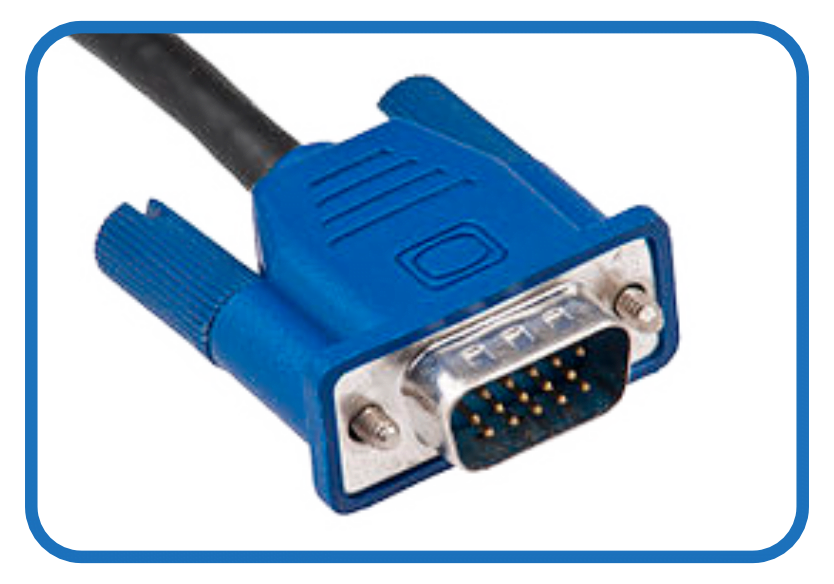
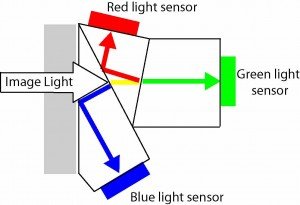 which generates a video signal representing the image. In a colour video camera, after coming through the lens the signal is split into three different colours (red, green and blue) through prisms. These coloured images then each go to a separate sensor, generating three separate video signals, one with the red picture information, one with the green picture information, and one with the blue picture information. These three separate video signals (Red, Green and Blue) is what is known as RGB video. It is the most pure form of analogue colour video signal.
which generates a video signal representing the image. In a colour video camera, after coming through the lens the signal is split into three different colours (red, green and blue) through prisms. These coloured images then each go to a separate sensor, generating three separate video signals, one with the red picture information, one with the green picture information, and one with the blue picture information. These three separate video signals (Red, Green and Blue) is what is known as RGB video. It is the most pure form of analogue colour video signal.
